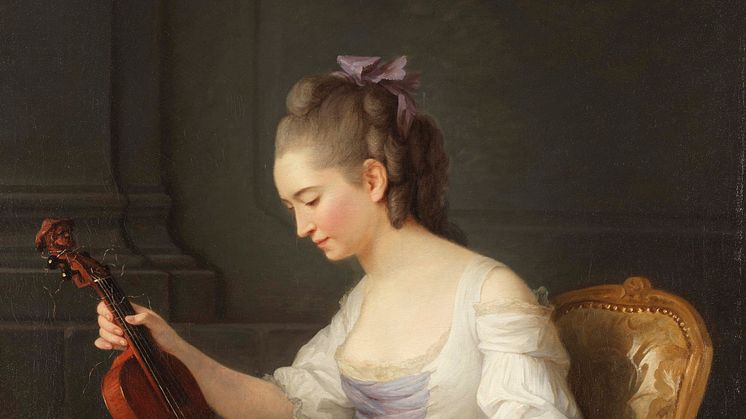
Press release -
New acquisition: Anne Vallayer-Coster’s painting of a female violinist
Anne Vallayer-Coster’s Portrait of a Violinist is the latest addition to Nationalmuseum’s collection of 18th-century French painting. Considered one of the artist’s masterpieces, this genre work is believed to portray one of her sisters. Painted in 1773, three years after Vallayer was elected to the French academy of art, the work has many artistic virtues.
Anne Vallayer (1744–1818) was elected to the French academy of art at the age of just 26. This was a remarkable event at the time, given the artist’s youth and the fact that she was a woman in a male-dominated institution, and an unmarried woman at that. There is no indication that Vallayer enjoyed royal patronage, but she did not lack for mentors in the ranks of the academy. Claude-Joseph Vernet, a landscape painter, had been her teacher. It was as a painter of still lifes that she was elected to the academy. Nationalmuseum already has two such works in its collection: Still Life with Brioche, Fruit and Vegetables (1775) and the miniature Floral Still Life (undated).
Vallayer, who in 1781 married Jean-Pierre-Silvester Coster, a successful lawyer, specialized primarily in floral painting. Thanks to her effective use of colour and skilful illusionism, her still lifes were much in demand, but ranked relatively low in the subject matter hierarchy of the time. Vallayer-Coster therefore tried to expand her range of motifs by deliberately incorporating objects more usually associated with historical painting. In the hope of attracting royal clients, she also painted portraits, which led to commissions from the king’s aunts and from Queen Marie Antoinette.
Despite her ambition of expanding her range of motifs, Vallayer-Coster painted very few portraits, and many of those that she did had a direct personal connection. In the light of this fact and a certain resemblance, researchers have suggested that Portrait of a Violinist is a genre painting of one of the artist’s three sisters, Madeleine, Elisabeth or Simone. It is not known whether any of them really did play the violin, but what is clear is that Vallayer-Coster had an extraordinary gift for depicting musical instruments, for instance. A sense of calm and contemplation permeates the self-contained composition. Even the broken strings contribute to the visual excellence of the image, while also raising questions as to their significance. Portrait of a Violinist undoubtedly ranks among the artist’s foremost works. Nationalmuseum’s purchase of this work has been made possible by a generous donation from the Wiros Fund. Nationalmuseum has no budget of its own for new acquisitions, but relies on gifting and financial support from private funds and foundations to enhance its collections of fine art and craft.
Press contacts
Magnus Olausson, Head of Collections and Research
magnus.olausson@nationalmuseum.se, +46 8 5195 4371
Hanna Tottmar, Press Officer
hanna.tottmar@nationalmuseum.se, +46 767 234632
Caption
Anne Vallayer-Coster, Portrait of a Violinist, 1773. Photo: Cecilia Heisser/Nationalmuseum.
Categories
Nationalmuseum is Sweden’s premier museum of art and design. The collections comprise older paintings, sculpture, drawings and graphic art, and applied art and design up to the present day. The museum building is currently under renovation and scheduled to open again in 2018. In the meantime, the museum will continue its activities through collaborations both in Sweden and abroad as well as temporary exhibitions at the Royal Swedish Academy of Fine Arts, Fredsgatan 12 and Nationalmuseum Design at Kulturhuset Stadsteatern in Stockholm. Nationalmuseum collaborates with Svenska Dagbladet, FCB Fältman & Malmén and Grand Hôtel Stockholm. For more information visit www.nationalmuseum.se.

